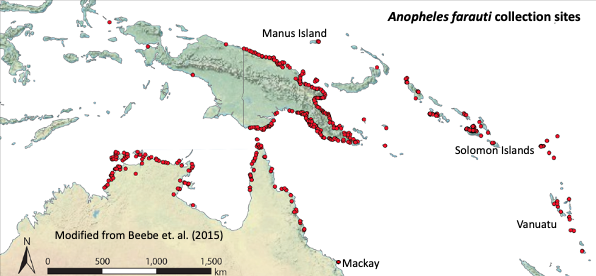Research
1) Malaria mosquitoes of our region
We have been studying the evolution, distribution and movement of Anopheles mosquito species across our region (Indo-Pacific) for over two decades. We developed and used DNA-based tools to distinguish the few malaria transmitting Anopheles species from the many non-vector species, map their distributions in order to study their biology, ecology and potential for adaptation to mosquito control strategies. Evolutionary and population genetic studies are also used to assess historical and contemporary movement. We work closely with the Australian Defence Force's Malaria and Infectious Diseases Institute (ADF-MIDI). Our aim is to deliver better knowledge on our regional malaria vectors, in part by developing an extensive malaria vector spatial-genetic database to assist in the design, execution and monitoring of future mosquito control strategies.
Malaria vector control: exploring the idea of a malaria resistant Anopheles farauti with the capacity to drive that trait into a population
Initial funding from the Bill and Melinda Gates Foundation and NHMRC will help us explore the potential of developing a Plasmodium falciparum refractory gene-drive Anopheles farauti (An. farauti distribution below). This malaria mosquito is difficult to control using traditional vector control tools. Here is an exciting opportunity to investigate this novel approach in collaboration with the Anthony James team at UC Irvine, and Greg Devine at the QIMR Berghofer Medical Research Institute.
We have been studying the evolution, distribution and movement of Anopheles mosquito species across our region (Indo-Pacific) for over two decades. We developed and used DNA-based tools to distinguish the few malaria transmitting Anopheles species from the many non-vector species, map their distributions in order to study their biology, ecology and potential for adaptation to mosquito control strategies. Evolutionary and population genetic studies are also used to assess historical and contemporary movement. We work closely with the Australian Defence Force's Malaria and Infectious Diseases Institute (ADF-MIDI). Our aim is to deliver better knowledge on our regional malaria vectors, in part by developing an extensive malaria vector spatial-genetic database to assist in the design, execution and monitoring of future mosquito control strategies.
Malaria vector control: exploring the idea of a malaria resistant Anopheles farauti with the capacity to drive that trait into a population
Initial funding from the Bill and Melinda Gates Foundation and NHMRC will help us explore the potential of developing a Plasmodium falciparum refractory gene-drive Anopheles farauti (An. farauti distribution below). This malaria mosquito is difficult to control using traditional vector control tools. Here is an exciting opportunity to investigate this novel approach in collaboration with the Anthony James team at UC Irvine, and Greg Devine at the QIMR Berghofer Medical Research Institute.
Anopheles farauti collections through the Southwest Pacific. This particular malaria vector presents strong behavioural resistance to indoor residue insecticide spraying and insecticide treated bednets. New approaches to control this mosquito will likely be required.
2) Endemic and exotic mosquitoes that are arbovirus vectors
Exotic arbovirus vectors
The exotic invasive dengue vector Aedes aegypti is extant to Queensland and could potentially re-emerge throughout Australia urban towns and cities driven by the changing climate and the expansion of domestic rainwater tanks ithat occured through 2000s millennlum drought to drought-proof our urban landscapes. Also of concern, the particularly pesky Asian tiger mosquito Aedes albopictus has expanded its distribution into the Torres Strait Islands and southern Papua New Guinea, now threatening to invade mainland Australia. We don't want the Asian tiger mosquito establishing on the Australian mainland, so we are working on developing species-specific population suppression tools to remove it when it arrives - see below for more detail.
Population reduction and removal of exotic Aedes vectors using reproductively incompatible males
We now further developing our sterile/incomparable males technology to reduce and remove exotic invasive Aedes mosquito species that transmit human pathogen. With an initial focus on the dengue mosquito (Aedes aegypti), funded through the NHMRC to use the bacterium Wolbachia as a reproductively incompatible male mosquito release technology to reduce and remove these mosquitoes from human landscapes. Our first field trial in Queensland's northern Cassowary Coast towns "Debug Innisfail" showed this Incompatible Insect Technique (IIT) to be viable -- thank you the the Cassowary Coast Community for being part of the science.
3) Australasian arbovirus vectors
Mosquitoes in the Culex sitiens subgroup are the major endemic arbovirus vectors of our region, transmitting many arboviruses including Ross River virus, Murry Valley encephalitis and Japanese encephalitis. The subgroup comprise Culex annulirostris and several putative cryptic species. We are using evolutionary and population genetics approaches to describe their cryptic species status, establish molecular diagnostics to better study the biology and ecology of these mosquitoes, especially in regard to the recent 2022 Japanese encephalitis outbreak across Australia.


